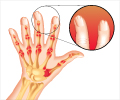Depressive symptoms are associated with increased disease severity and decreased physical performance among patients with knee osteoarthritis (OA). Disease progression in patients with knee OA can lead to deteriorating psychosocial health.

‘A patient’s feeling can worsen or reduce symptoms in knee osteoarthritis. Depressive symptoms are associated with increased disease severity and decreased physical performance among patients with knee osteoarthritis (OA).’





"We know that disease progression in patients with knee OA can lead to deteriorating psychosocial health," said Professor Thomas Dörner, Chairperson of the Abstract Selection Committee, EULAR. "The results of this study provide valuable insights into the components of OA disease severity which are related to depression onset." The study examined three predictors of OA disease severity; structural severity (joint space width), physical performance (gait speed), and pain (subscale of the WOMAC Index). Each measure was operationalized as time-averaged severity and grouped in to quintiles, and results showed that depressive symptom onset was associated with increased severity for two of the three predictors. In order of increasing magnitude, the odds ratios comparing highest to lowest severity quintiles were 1.60 for pain (95% CI: 0.81-3.16), 2.08 for gait speed (95% CI: 1.16-3.75), and 2.25 for joint space width (95% CI: 1.27-3.99).
"Given the results of our study, we believe that to effectively treat individuals with radiographic knee OA and comorbid depressive disorder, it is necessary to use a combined treatment strategy of two interventions delivered in parallel to simultaneously target each condition," said Alan M. Rathbun, Ph.D., M.P.H., Research Associate in the Departments of Epidemiology and Medicine at the University of Maryland School of Medicine and Special Fellow at the Geriatric Research Education and Clinical Center in the VA Maryland Health Care System.
Eligible participants (n=1,652) were selected from the Osteoarthritis Initiative who had radiographic disease† and were classified as without depressive symptoms at study baseline. Osteoarthritis disease severity was assessed at the beginning of the study using joint space width, 20-meter gait speed and pain§ and then at three annual follow-up visits. These severity predictors were evaluated as a moving average at each time point then categorized into quintiles. Depressive symptom onset was assessed at four annual follow-up visits using the CES-D scale. Statistical modeling and analysis evaluated the association between each disease severity predictor and onset of depressive symptoms.
Source-Eurekalert















